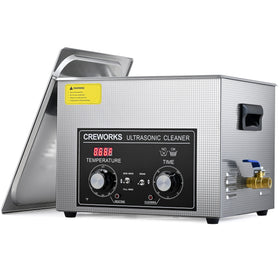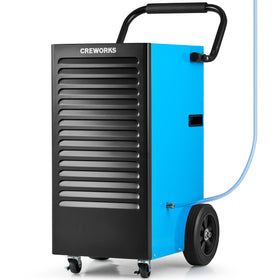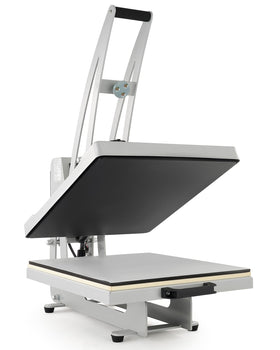
Certified Business
With over 10000+ orders
With over 10000+ orders

Ultrasonic vinyl record cleaners are becoming ever more popular for audiophiles and are threatening to become the de-facto standard for any serious vinyl fan wanting to maintain a shiny, clean record collection.
In simple terms, such machines hold and rotate a record that is partly submerged in a bath of liquid. That type of liquid can vary from manufacturer to manufacturer but the bulk tends to be distilled water. Once the record is wet (the label is always left untouched, incidentally), the ultrasonic action known as cavitation begins in the bath container via an active transducer, producing compression waves that produces millions of tiny bubbles that break up, creating millions of tiny bubble explosions, directed liquid that is fired and forced into the moving grooves. The agitation effect displaces gunk, grease, muck and other contaminants, cleaning the grooves like never before.

GT Sonic bath with drain point [right]
Other vinyl fans are becoming fans too but are now faced with a supply of ultrasonic record cleaning machines (RCM) that is splintering into two factions: the professionally-built, fully featured and rather expensive models and the basically constructed, lower cost variant. I decided to get to grips with an example of the latter from Record Cleaner Pro.
The entire point of the Record Cleaner Pro is the price. This is, a cost-oriented product. One that has been built to do a job, but one that minimises outlay. Luxuries and fripperies have been dropped to lower the cost.
Because of that, you need to know what you’re getting yourself into and why. There may be some readers who may think that they’re getting a cleaner of the same category as the Audiodesk model I reviewed a while back. This is not so and, in fact, the more expensive Audiodesk is a good basis for comparison to prove that very point.
Unlike the Audiodesk which arrives ready to use and within a self contained unit, the Record Cleaner Pro needs to be assembled before use which could be and, in fact was, a problem. How do you put the thing together? Apart from the tank itself I was faced with numerous plastic bags of bits and an instruction sheet of text that could be read and interpreted in various ways.
When faced with any sort of construction, you need simple and fool-proof illustrations to fix position, orientation and an order of build (just ask IKEA). What I had was a single piece of paper, lines of text only and numbered paragraphs.
Now, there are not too may parts here and with a few moments of quiet contemplation, most people will be able to figure out what goes where and how. That’s not really the point, though. The company shouldn’t be assuming. It should be covering its back-side to make absolutely sure that everyone knows how to get this machine up and running. As it is, the instructions are just not good enough.
[NOTE: I mentioned the above to the company, Record Cleaner Pro, and it has now said it will post instructional videos on its new upcoming website as well as improve the physical instructions, adding a graphical guide.]
The majority of the construction of this cleaning machine is ‘bought in’ from a third party and has no direct connection to Record Cleaner Pro at all. More to the point, Record Cleaner Pro is not in control the part of the RCM that does the actual cleaning. That’s left to the GT Sonic Digital Ultrasonic Cleaner. This is a separate and independent item. It arrives with a six litre bath, adjustable timer and heat settings and can be bought, on its own, from Store for £104.39 (the price stated going to press) HERE. This is but one outlet for the bath. Lots of other people sell it too.
Thus, what you are actually buying from Record Cleaner Pro is a motor assembly (see image below), attachments and vinyl holder that adds to and changes the nature of the original GT Sonic product from a general cleaner for, say, jewellery to a vinyl record cleaner. To confirm then, you need two products: the bath created by GT Sonic and the motor assembly from Record Cleaner Pro. Both can be purchased from the company or you can just buy the vinyl-specific additions.

The record holder is connected to the motor unit via a magnet. The ‘shim’ block [lower centre] is required to properly connect the motor unit to the GT Sonic bath, further emphasising the lack of integration
Having two power cables means more mess, more fuss and the use, of course, of two power sockets. You need to decide whether that, in itself is a problem.
In addition, I don’t have an immediate concern but I am also just a little perturbed that the motor assembly’s power socket is relatively near the opening of the bath and all of that liquid. Call me paranoid – and I’m probably being needlessly over anxious about this – but that, in itself, rings a tiny alarm bell.
To use the machine, you fill the bath with Record Cleaner Pro’s concentrated cleaning liquid called Wet Stuff. You receive a small bottle when you buy the RCM. The 100ml of concentrate is diluted into distilled water and is apparently good for up to 25 uses. This liquid apparently uses alcohol as a surfactant to break surface tension and improve cleaning. Many readers will see alcohol as an aggressive medium when used with vinyl and would rather not use it at all. Record Cleaner Pro (the company) did state that the amount of alcohol volume, when mixed with the bath of distilled water, is so small that no damage will occur over the short or long term.
I used to have a zero tolerance with isopropyl alcohol and its use with vinyl records but new research may prove that tiny amounts of the stuff, mixed with large amounts of distilled water, may have some significant, non-aggressive, cleaning benefits within the vinyl groove. The jury is still out, in terms of my own conclusions because I’m still researching this area so you must make a judgement here for the immediate future and this machine.
The point is easily moot, though because you can just bin the alcohol supplied and use your own surfactant. Which solves the case there and then.
That said, as this liquid is part of the product and I’m here to test that product, I did utilise this liquid during the sound tests with a ‘spare’ vinyl disc.
Unlike the Audiodesk which automatically sets the physical amount of liquid used in the bath to clean the record but protects the label from a good soaking, the Record Cleaner Pro does no such thing. That is, you have no real idea how high to fill the bath with liquid. There are no markings inside the bath that act as a guide. You will need trial and error here to find the correct liquid level.
The reason for the lack of markings can be found via that Store link image. The GT Sonic bath is designed to be used with a basket. The idea is to place the dirty items in that basket and then you cover them with distilled water. In this way, the bath/basket created its own, rather practical, level. That is, as long as you cover the offending item, you’re fine. Take out the basket, put in the vinyl and you’re guessing.
Once assembled, you undo the vinyl holder’s wing nut and slide off up to four small pucks. These pucks partly cover the record label (see image above) but also hold the vinyl in position during cleaning. I say “partly cover” and I mean that. There’s no protection against the liquid from the pucks themselves. Which means that finding a proper water level is doubly urgent.
Once the vinyl (up to four discs can be loaded) is in place and the wing nut has been re-applied and tightened, the tank’s own timer is set for a recommended 12-15 minutes while the temperature is set for up to a recommended 25 degrees Centigrade (the Audiodesk offers no temperature options and its cleaning cycle is only a few minutes long). After cleaning, you are advised to leave the records to stand in a rack to dry.
Record Cleaner Pro also adds the suggested option to clean the record with a microfibre cloth (not supplied).
There are issues here. In this bath, after cavitation, you would hope that most of the grime would fall into the bottom of the bath, clearing the vinyl and preventing recontamination. Drying the surface of the record with a light pressure application of a microfibre cloth is a good idea because it will lift liquid into the cloth (along with vagrant bits of grime) without leaving lint. I wonder if that is enough, though. I would have liked to have seen the additional of a manual cleaning kit to further ensure that recontamination is minimised, at least as an optional extra. Something akin to the new Kirmuss RCM, for example. The latter includes cloths, brushes, washes and more in an attempt to minimise the reintroduction of dirt.
To be honest, though, recontamination threats are an issue with most ultrasonic RCMs. Audiodesk, upon finishing its cleaning cycle, drains the liquid through an internal filter and dries the LP with its own internal fan drier. This system opens itself up to several recontamination questions but the Audiodesk still, in the end, works wonderfully, at least in sonic performance terms.
There are other points of note here for the Record Cleaner Pro. Firstly, you have to carefully position the motor assembly every time you reattach it (say, after changing the liquid) because that assembly doesn’t fit into a prepared slot, it is freely clamped on the bath’s rim. You need to gently rotate your vinyl to make sure that it doesn’t hit either side during cleaning. The Audiodesk fits into a pre-prepared position with no adjusting necessary.
Next, in operation, the cavitation process from the Record Cleaner Pro is relatively noisy. The Audiodesk is not silent but is nothing like as aggressive sounding.
There is a final but possibly more fundamental issue with the GT Sonic bath. It’s the fact that it is aimed at general use, not cleaning vinyl records. It’s own sales pitch advertises it as being able to clean “Jewellery, Rings, Watches, Eyeglasses, Dentures, Coins, Metal Parts, Lab Tools…”
Which begs the questions, how does the Record Cleaner Pro perform?
I loaded the machine with one LP, Vic Damone’s On The Street Where You Live and played the title track. It was full of low level Rice Krispie noises which were a steady and consistent interference throughout the song. I played this track several times to make sure that the noises were a true fixture and would not be loosened by the action of the stylus alone.
I then plunged the LP into the Record Cleaner Pro bath and set the timer for the recommended 15 minutes and the temperature to 25 degrees, the upper level of the recommended settings. You will find that the temperature will rise slowly. For example, with 10 minutes to go, the temperature had risen to 18 degrees and 19 degrees with eight and half minutes to go.

GT Sonic bath interface
After the RCM had completed its clean and the disc had dried, playing the very same record revealed that the Rice Krispies remained but in much reduced manner.
Possibly more important, though, was the increase in overall sound quality as the soundstage was opened up, midrange dynamics were extended, bass was fuller, more air was present around the soundstage while the backing orchestra sounded more vital and alive, less muffled and subdued.
I cleaned the record a few more times to hopefully reach a set plateau in which you would reasonably expect no extra performances benefits to arise from the Record Cleaner Pro and then cleaned the disc in the Audiodesk, just to see if the more expensive machine would add anything at all to the cleaning process. It did. Basically, it moved the sonic improvements further on down the road, adding more of everything. Items of note included the emergence of extra bass, extra clarity in the lead vocals, the further reduction of the low level noise (the Rice Krispie noise effect was further improved) and a more mature sonic balance. That is, instruments and voice seemed to fit logically and easily together.
I’ve given this RCM a relatively low rating but that’s because of the design issues, not solely because of its inherent performance.
What I mean is that the Record Cleaner Pro feels like two constrasting and sometimes conflicting products. Not an integrated RCM. That, in itself is my principle issue with this RCM, along with the fact that the bath has not been modified to work with vinyl. It remains an ultrasonic bath for general use.
In effect, the Record Cleaner Pro company has had to ‘make do’ with the supplied ultrasonic bath and adapt its own technology to that bath. Which causes compromises.

As I mentioned at the beginning of this review, those design areas are there for a reason: to cut corners and thus reduce the price which, when it comes down to it, is fine if you buy this RCM with your eyes wide open. Those design issues are sometimes irritating or they make the job harder or longer but they do enable you to enter into ultrasonic territory, especially if the budget is low.
In performance terms, the cleaning action of this RCM is good – not wonderful – but good. After all, the GT Sonic, the bit that does the actual cleaning, is a low cost, budget product.
Despite the low rating, this RCM does work, it does do the job and the sound quality of treated records does improve. The Record Cleaner Pro is a useful entry point to the world of ultrasonic cleaning.












Leave a comment